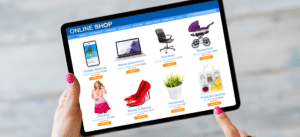Essential eCommerce Practices to Skyrocket Your Sales
Key Takeaways
- A mobile-first design ensures your website is accessible and functional across all devices.
- Simplified navigation reduces friction and helps users find products quickly.
- High-quality visuals and detailed product descriptions build trust and increase conversions.
- Trust signals and a seamless checkout process are critical for reducing cart abandonment.
- Continuous testing and optimization keep your website competitive and user-friendly.
Why eCommerce Website Design Matters
Your eCommerce website isn’t just a digital storefront—it’s the heart of your business. It’s where first impressions are made, trust is built, and sales happen. But here’s the thing: a poorly designed website can drive potential customers away faster than you can say “bounce rate.”
Think about your own experiences. Have you ever landed on a website that felt outdated, slow, or confusing? You probably didn’t stick around long. That’s the challenge (and the opportunity) of eCommerce website design—it can either make or break your business.
This blog dives into the 5 essential eCommerce website design best practices that every online store needs to succeed. These aren’t just tips—they’re game-changers. Let’s get started.
1. Mobile-First Design
Why Mobile-First Design Is Non-Negotiable
Did you know that over half of global web traffic comes from mobile devices? That means your customers are more likely to browse and shop on their phones than on a desktop. If your website isn’t optimized for mobile, you’re losing out—plain and simple.
Google also prioritizes mobile-first indexing, meaning your mobile site is what determines your search rankings. If your mobile experience is subpar, your SEO (and your sales) will suffer.
Key Features of Mobile-First Design
- Responsive Layouts: Your website should automatically adjust to fit any screen size, whether it’s a smartphone, tablet, or desktop.
- Simplified Menus: Use collapsible menus and sticky headers for easy navigation on smaller screens.
- Optimized Media: Compress images and videos to ensure fast loading times without sacrificing quality.
Real-World Example:
A small boutique I worked with revamped their website with a mobile-first approach. They simplified their menus, optimized their images, and made their checkout process mobile-friendly. The result? A 40% increase in mobile conversions within three months.
2. Streamlined Navigation
Why Navigation Is Crucial
Have you ever visited a website and felt lost? Poor navigation can frustrate users and drive them away. On the flip side, intuitive navigation helps users find what they’re looking for quickly, reducing bounce rates and increasing sales.
Best Practices for Navigation
- Clear Categories: Organize your products into logical categories and subcategories. For example, a clothing store might have sections for “Men,” “Women,” and “Accessories,” with further subcategories like “Shirts” or “Shoes.”
- Search Bar with Autocomplete: A prominent search bar is a must. Autocomplete suggestions can guide users even if they’re unsure of what they’re looking for.
- Breadcrumb Navigation: This feature shows users where they are on your site and allows them to backtrack easily.
Pro Tip:
Use analytics tools to track how users navigate your site. If you notice that certain pages have high exit rates, it might be time to rethink your menu structure.
A well-designed eCommerce website isn’t just a digital storefront—it’s a powerful tool that builds trust, enhances user experience, and drives sales.
3. High-Quality Visuals and Product Descriptions
The Power of Visuals in eCommerce
When customers can’t touch or try your products, visuals become their primary decision-making tool. High-quality images and videos can make or break a sale.
What to Include:
- Multiple Angles: Show your products from every perspective.
- Zoom Functionality: Let users see the details up close.
- Product Videos: A short video demonstrating the product in action can be incredibly persuasive.
Don’t Forget the Copy
Your product descriptions are just as important as your visuals. They should be detailed, engaging, and focused on the benefits of the product. Avoid generic phrases like “high quality” or “best in the market.” Instead, highlight specific features and how they solve customer problems.
Example:
A furniture retailer added 360-degree product views and detailed descriptions that included dimensions, materials, and care instructions. Their sales increased by 25% within a month.
4. Trust Signals and Seamless Checkout
Why Trust Is Everything
Online shopping requires a leap of faith. Customers need to trust that your website is secure, your products are as advertised, and their data is safe.
How to Build Trust
- Customer Reviews and Ratings: Display testimonials prominently.
- Trust Badges: Include SSL certificates, secure payment icons, and “Verified Purchase” badges.
- Transparent Policies: Be upfront about returns, refunds, and shipping.
Smoothing the Checkout Process
A complicated checkout process is one of the biggest reasons for cart abandonment. Here’s how to fix it:
- Guest Checkout: Not everyone wants to create an account.
- Auto-Fill Forms: Save your customers time by pre-filling fields where possible.
- Multiple Payment Options: Offer credit cards, PayPal, Apple Pay, and more.
Case Study:
An online cosmetics store simplified their checkout process and added trust badges. Their cart abandonment rate dropped by 18%, and sales increased by 20%.
5. Continuous Testing and Optimization
Why Testing Never Ends
Your website isn’t a “set it and forget it” project. User behavior changes, technology evolves, and trends shift. Continuous testing ensures your site remains effective and competitive.
What to Test:
- A/B Testing: Experiment with different layouts, CTAs, and visuals to see what works best.
- Heatmaps: These tools show you where users are clicking, scrolling, and spending the most time.
- Feedback Forms: Ask your customers what they like and what they’d change.
Pro Tip:
Even small tweaks can make a big difference. For example, changing the color of a CTA button or simplifying a form can significantly boost conversions.
We Build Cool

Success Stories
365 Data Centers
Discover how we rapidly rebuilt and optimized a 30-page website for 365 Data Centers, restoring their online presence and managing digital ad campaigns across key regions to drive engagement and growth.
XTECH Football Pads
Discover how we transformed XTECH Football Pads‘ digital presence, boosting their online sales and tripling website traffic through innovative website development and user experience enhancements.
BeEarth Foundation
Discover how we partnered with the BeEarth Foundation to develop a website that aligns with their mission of sustainability and global engagement. Our work has significantly increased their online visibility and engagement, supporting their efforts to promote sustainable development.
We Recycle Solar
Learn how we illuminated digital success for We Recycle Solar by completely redesigning their website to reflect their leadership in the growing solar recycling industry and implementing strategic digital advertising campaigns that enhanced their visibility at key industry events.
Preferred Home Health Care & Nursing Services
Explore how we elevated the digital presence of Preferred Home Health Care & Nursing Services by enhancing their website for better lead generation, building a dedicated site for staff recognition, and optimizing SEO for their location pages.
What Our Clients Say: Elevating Online Success
Conclusion: The Blueprint for eCommerce Success
A well-designed eCommerce website isn’t just about aesthetics—it’s about creating a seamless, intuitive, and engaging experience that meets your customers’ needs. From prioritizing mobile-first design to building trust with transparent policies and social proof, every detail matters.
But here’s the thing: no website is ever truly “finished.” Trends change, customer expectations evolve, and technology advances. That’s why continuous testing and optimization are so important. It’s not about perfection—it’s about progress.
If there’s one takeaway from this blog, it’s this: your website is a living, breathing part of your business. Treat it like one. Keep it fresh, keep it functional, and most importantly, keep it focused on your customers.
Ready to take the next step? Whether you’re building a new online store or optimizing an existing one, the strategies outlined here will set you on the path to long-term success.
FAQs
Answer: With over half of web traffic coming from mobile devices, a mobile-first design ensures your website is accessible and functional for the majority of users.
Answer: Simplify your menu structure, add a prominent search bar, and use breadcrumbs to guide users.
Answer: High-quality images, multiple angles, zoom functionality, and product videos help customers make informed decisions.
Answer: Trust signals like reviews, secure payment icons, and transparent policies reassure customers and reduce cart abandonment.
Answer: Testing helps you stay ahead of trends, adapt to user behavior, and keep your website performing at its best.
Let's Build Something Sublyme
Ready to take your eCommerce website to the next level? At Sublyme Digital, we specialize in creating high-performing websites that drive results. Contact us today to get started!



